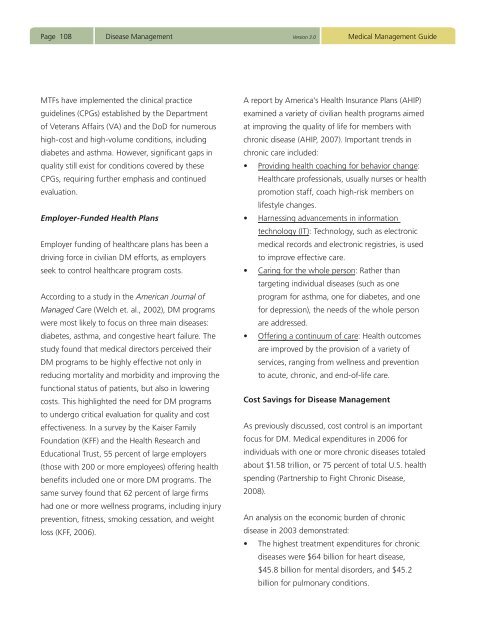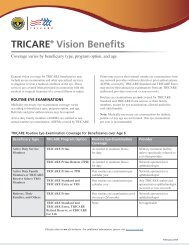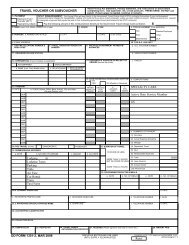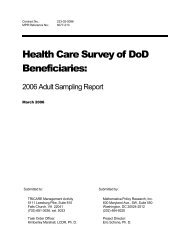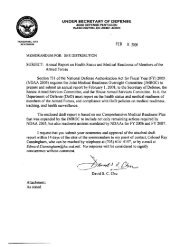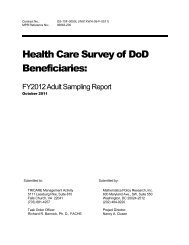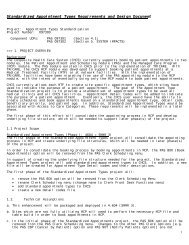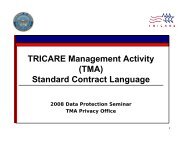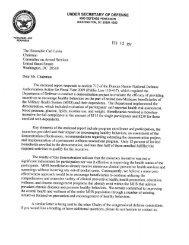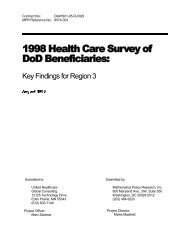Medical Management Guide, 2009, Version 3.0 - Tricare
Medical Management Guide, 2009, Version 3.0 - Tricare
Medical Management Guide, 2009, Version 3.0 - Tricare
- No tags were found...
Create successful ePaper yourself
Turn your PDF publications into a flip-book with our unique Google optimized e-Paper software.
Page 108Disease <strong>Management</strong> <strong>Version</strong> <strong>3.0</strong><strong>Medical</strong> <strong>Management</strong> <strong>Guide</strong>MTFs have implemented the clinical practiceguidelines (CPGs) established by the Departmentof Veterans Affairs (VA) and the DoD for numeroushigh-cost and high-volume conditions, includingdiabetes and asthma. However, significant gaps inquality still exist for conditions covered by theseCPGs, requiring further emphasis and continuedevaluation.Employer-Funded Health PlansEmployer funding of healthcare plans has been adriving force in civilian DM efforts, as employersseek to control healthcare program costs.According to a study in the American Journal ofManaged Care (Welch et. al., 2002), DM programswere most likely to focus on three main diseases:diabetes, asthma, and congestive heart failure. Thestudy found that medical directors perceived theirDM programs to be highly effective not only inreducing mortality and morbidity and improving thefunctional status of patients, but also in loweringcosts. This highlighted the need for DM programsto undergo critical evaluation for quality and costeffectiveness. In a survey by the Kaiser FamilyFoundation (KFF) and the Health Research andEducational Trust, 55 percent of large employers(those with 200 or more employees) offering healthbenefits included one or more DM programs. Thesame survey found that 62 percent of large firmshad one or more wellness programs, including injuryprevention, fitness, smoking cessation, and weightloss (KFF, 2006).A report by America’s Health Insurance Plans (AHIP)examined a variety of civilian health programs aimedat improving the quality of life for members withchronic disease (AHIP, 2007). Important trends inchronic care included:• Providing health coaching for behavior change:Healthcare professionals, usually nurses or healthpromotion staff, coach high-risk members onlifestyle changes.• Harnessing advancements in informationtechnology (IT): Technology, such as electronicmedical records and electronic registries, is usedto improve effective care.• Caring for the whole person: Rather thantargeting individual diseases (such as oneprogram for asthma, one for diabetes, and onefor depression), the needs of the whole personare addressed.• Offering a continuum of care: Health outcomesare improved by the provision of a variety ofservices, ranging from wellness and preventionto acute, chronic, and end-of-life care.Cost Savings for Disease <strong>Management</strong>As previously discussed, cost control is an importantfocus for DM. <strong>Medical</strong> expenditures in 2006 forindividuals with one or more chronic diseases totaledabout $1.58 trillion, or 75 percent of total U.S. healthspending (Partnership to Fight Chronic Disease,2008).An analysis on the economic burden of chronicdisease in 2003 demonstrated:• The highest treatment expenditures for chronicdiseases were $64 billion for heart disease,$45.8 billion for mental disorders, and $45.2billion for pulmonary conditions.


